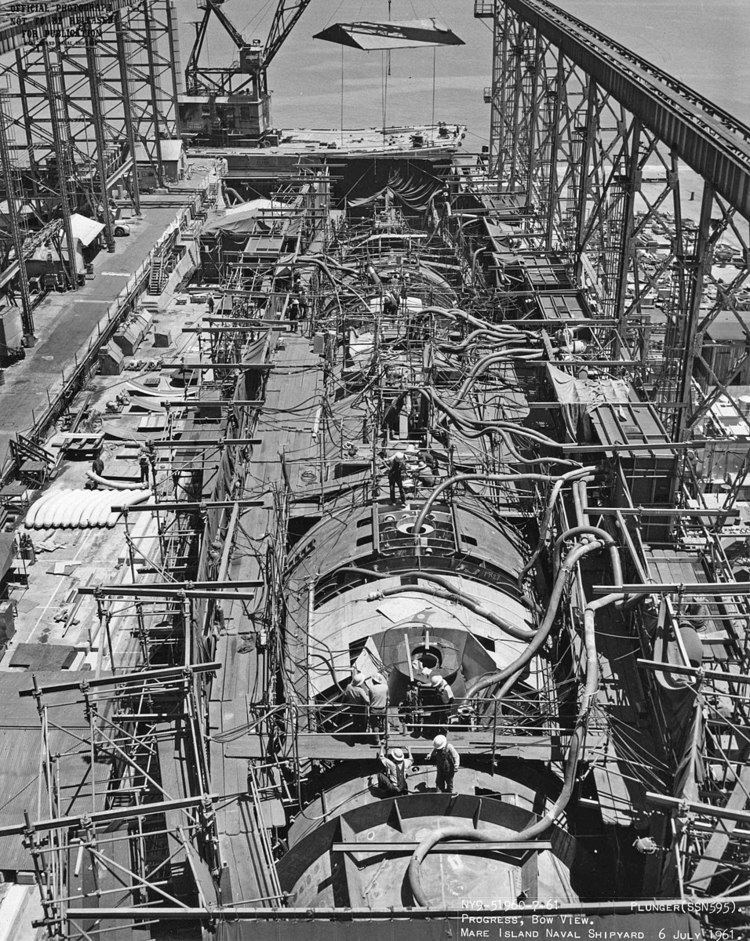 | ||
HY-80 is a high-tensile alloy steel. It is most notable for its use in the construction of pressure hulls for US nuclear submarines in the 1950s to 1980s.
Contents
The 'HY' steels are a series of steels with high yield strength, hence the name. Their numbers, HY-80, HY-100, HY-130 refer to their yield strength in ksi, i.e. HY-80 has a yield strength of 80,000 psi (550 MPa), and HY-100 of 100,000 psi (690 MPa).
Submarines
The need to develop improved steels was driven by a desire for deeper-diving submarines. To avoid detection by sonar, submarines ideally operate at least 100 metres below the Sonic Layer Depth. World War II submarines operated at a total depth of rarely more than 100 metres. With the development of nuclear submarines, their new independence from the surface for an air supply for diesel engines meant that they could focus on hidden operation at depth, rather than operating largely as surface-cruising submersibles. The increased power of a nuclear reactor allowed their hulls to become larger and faster. Developments in sonar made them able to hunt effectively at depth, rather than relying on visual observations from periscope depth. All these factors drove a need for improved steels for stronger pressure hulls.
The strength of a submarine hull is not merely that of absolute strength, but rather yield strength. As well as the obvious need for a hull strong enough not to be crushed at depth, the hundreds of dives over a submarine's lifetime mean that the fatigue life is also an important issue. To provide resistance to fatigue, the hull must be designed so that the steel always operates below its elastic limit; that is the stress applied by pressure is less than its yield stress. The HY- series steels were developed to provide a high yield stress, so allowing this.
US submarines post-WWII, both conventional and nuclear, had improved designs compared to the earlier Fleet submarines. Their steel was also improved and was the equivalent of "HY-42". Boats of this construction included USS Nautilus, and the Skate-class, which were the first nuclear submarines, with the then-conventional hull shape. The later Skipjack class, although of the new Albacore 'teardrop' hull form, also used these earlier steels. Such boats had normal operating depths of some 700 feet (210 m), and a crush depth of 1,100 feet (340 m).
Although the operating depths of submarines are highly secret, their crush depth limits can be calculated approximately, solely from knowledge of the steel strength. With the stronger HY-80 steel, this depth increased to 1,800 feet (550 m)] and with HY-100 a depth of 2,250 feet (690 m).
HY-80 steel was first used in 1953 for the construction of USS Albacore, a small diesel research submarine. Albacore tested its eponymous teardrop hull shape, which would form a pattern for the following US nuclear classes.
The first production submarines to use HY-80 steel were the Permit class. These reportedly had a normal operating depth of 1,300 feet, roughly two-thirds the crush depth limit imposed by the steel. USS Thresher, the lead boat of this class, was lost in an accident in 1963. At the time, this unexplained accident raised much controversy about its cause and the new HY-80 steel used was looked at suspiciously, especially for theories about weld cracking having been the cause of the loss.
HY-100 steel was introduced for the deeper diving Seawolf class, although two of the preceding HY-80 Los Angeles class, USS Albany (1987) and USS Topeka, had trialled HY-100 construction. USS Seawolf is officially claimed to have a normal operating depth of "greater than 800 feet". Based on the reported operating depth of Thresher, it may be assumed that the normal operating depth of Seawolf is roughly double the official figure.
HY-100 too was dogged by problems of weld cracking. Seawolf's construction suffered setbacks in 1991 and an estimated 15% or two years' work on hull construction had to be abandoned. Although later solved, these extra costs (and the post-Soviet peace dividend) were a factor in reducing the planned 29 Seawolf submarines to just three constructed.
Metallurgy
HY-80 is a low carbon, low alloy steel with nickel, chromium and molybdenum (Ni-Cr-Mo) as alloying elements. It has excellent weldability and notch toughness along with good ductility even in welded sections. Their strength and toughness develops during manufacture by a heat-treatment process of quenching and tempering.
HY-80 and HY-100 are covered in the following US military specifications:
Alloy content
The precise range of permitted alloy content varies slightly according to the thickness of the sheet. The figures here are for thicker sheets, 3 inches (76 mm) and over, which are the more restrictive compositions.
A further steel, HY-130, also includes vanadium as an alloying element. Welding of HY-130 is considered to be more restricted, as it is difficult to obtain filler materials that can provide comparable performance.
Testing
The ultimate tensile strength of these steels is considered secondary to their yield strength. Where this is required to meet a particular value, it is specified for each order.
Notch toughness is a measure of tear resistance, a steel's ability to resist further tearing from a pre-existing notch. It is usually evaluated as the tear-yield ratio, the ratio of tear resistance to yield strength.
Wrought HY-80 steels are produced by, amongst others, ArcelorMittal in the USA, and castings in HY80 by Goodwin Steel Castings in the UK
